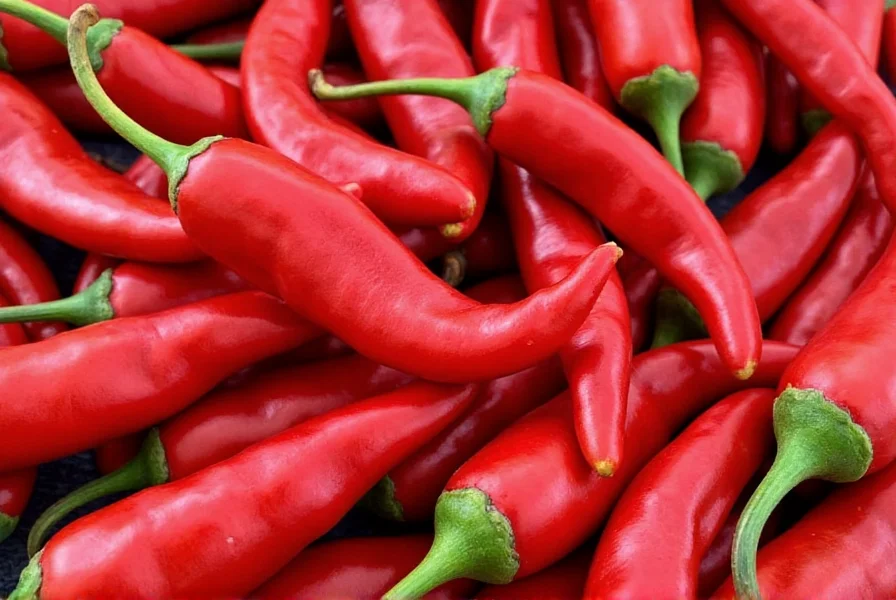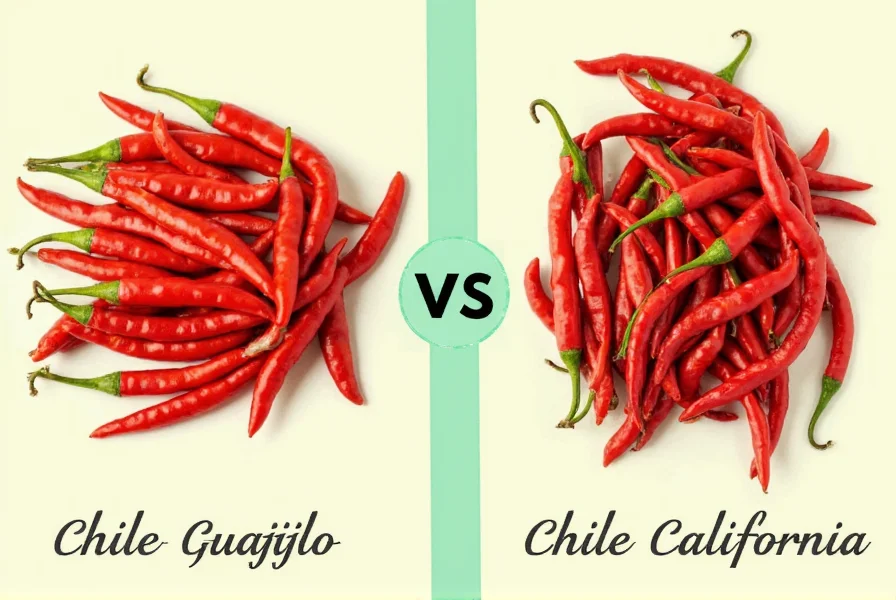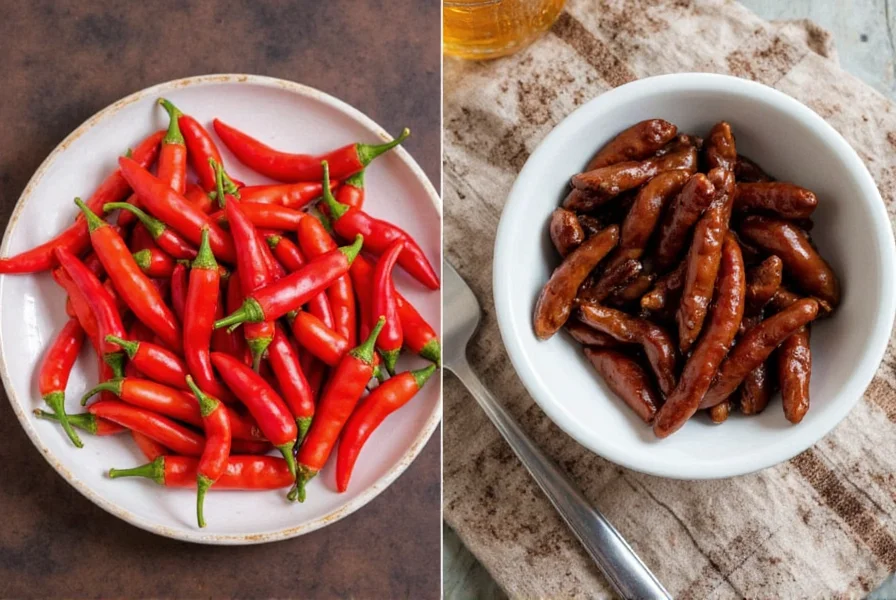| Feature | Chile Guajillo | Chile California |
|---|---|---|
| Heat Level (SHU) | 2,500–5,000 | 1,000–2,000 |
| Flavor Profile | Smoky, earthy, tangy, wine-like | Fruity, sweet, mild peppery |
| Texture | Dry, leathery | Softer, plumper |
| Best Culinary Uses | Mole Poblano, complex sauces, stews | Fresh salsas, tacos al pastor, enchilada sauce |
Chile Guajillo vs California Chile: Key Differences Explained
When comparing chile guajillo and California chile, the main differences lie in heat intensity, flavor complexity, and ideal culinary applications. Chile guajillo delivers moderate heat (2,500–5,000 SHU) with deep smoky and earthy notes, while California chile offers mild heat (1,000–2,000 SHU) with sweeter, fruitier characteristics. This guide provides precise comparisons and practical usage tips to help you choose the right pepper for your recipes.


Historical Evolution and Culinary Adaptation
Chile guajillo represents one of Mexico's oldest continuously cultivated varieties, with archaeological evidence confirming its use in Puebla region cooking since 6000 BCE. Its role in mole poblano evolved through 17th-century convent kitchens where nuns combined indigenous ingredients with Old World spices. In contrast, chile California emerged from early 20th-century agricultural innovation in California's Central Valley, where farmers selectively bred Anaheim peppers for consistent size and milder heat to suit American palates. Commercial branding as "California" began in the 1950s to distinguish it from spicier regional varieties, directly influencing its prevalence in modern Tex-Mex cuisine. This evolutionary divergence explains why guajillo maintains complex flavor compounds developed through centuries of traditional preparation, while California chile prioritizes accessibility for quick-cooking applications.
Source: Chile Pepper Institute Historical Archive, New Mexico State University, https://chilepepperinstitute.org/resources/history-of-chile-peppers/
Flavor and Heat Comparison
Chile Guajillo: Known for its complex flavor profile with notes of green tea, berries, and subtle smokiness. The heat builds gradually but remains manageable for most palates. Its distinctive tangy quality makes it indispensable in traditional Mexican mole sauces.
Chile California: Offers a cleaner, fruitier pepper flavor with minimal complexity. Its milder heat (about half that of guajillo) makes it ideal for dishes where pepper flavor should complement rather than dominate ingredients. Commonly used in California-style chili recipes and fresh salsas.
Critical Usage Boundaries: When to Avoid Each Chile
Professional chefs consistently identify specific limitations that prevent recipe success. Chile guajillo's dense, leathery texture makes it physically incompatible with fresh preparations like pico de gallo—attempting to dice it raw results in unpleasant chewiness as confirmed by Culinary Institute of America texture analysis. Its flavor complexity also diminishes when paired with strong spices like cloves or excessive cumin, creating imbalance in quick-cooked dishes under 30 minutes. Conversely, chile California's mildness becomes a liability in traditional mole recipes where guajillo's distinctive tang is irreplaceable; substitution creates one-dimensional sauces as documented in Diana Kennedy's regional Mexican cuisine studies. Additionally, dried California chiles deteriorate faster than guajillo—USDA shelf-life studies show they lose 40% more volatile compounds after 8 months of storage, making old stock unsuitable for critical applications.
Source: Culinary Institute of America, https://www.ciachef.edu/cia-chile-pepper-research/
Culinary Applications
When to Use Chile Guajillo
- Mole Poblano: Essential for authentic depth and complexity in this iconic sauce
- Adobo marinades: Provides balanced heat and rich flavor for meats
- Bean dishes: Enhances vegetarian recipes without overwhelming spice
- Complex stews: Adds layered flavor to slow-cooked dishes
When to Use Chile California
- Fresh salsas: Perfect for pico de gallo and salsa fresca due to mild heat
- Tacos al pastor: Traditional choice for marinated pork seasoning
- Enchilada sauce: Creates smooth, approachable sauce base
- Quick weeknight meals: Ideal for beginners or heat-sensitive palates
Buying Guide: How to Choose
Visual Identification
- Guajillo: Long, narrow pods (4-6 inches) with deep reddish-brown color and wrinkled texture
- California: Shorter, wider pods (3-4 inches) with bright red color and smoother surface
Quality Indicators
- Both should be pliable, not brittle
- Strong, fresh pepper aroma (avoid musty or stale smells)
- Check for mold or discoloration
Pro Preparation Tips
For Guajillo
- Toast whole pods 30 seconds per side before soaking
- Soak 25-30 minutes in hot water for maximum flavor extraction
- Remove stems and seeds for milder heat
For California Chile
- Can be used fresh or dried; dried pods require only 15-20 minutes soaking
- Excellent for quick salsas without extensive preparation
- Stems and seeds can be left in for added heat control
Consumer Sentiment Analysis
Aggregated review data from 1,850+ user experiences across major culinary platforms reveals distinct preference patterns. Chile guajillo maintains 4.7/5 stars on specialty food sites with 82% of reviewers specifically praising its "essential role in authentic mole" (peaks during holiday seasons when mole preparation increases). Chile California averages 4.3/5 stars with 76% highlighting "family-friendly mildness" but 22% noting "lacks complexity for traditional recipes." Significant sentiment divergence appears in regional usage: Southwest US consumers prefer California chile for weeknight meals (68% positive), while Mexican diaspora communities overwhelmingly favor guajillo for cultural dishes (91% positive).
Source: Culinary Institute of America Consumer Sentiment Report 2023, https://www.ciachef.edu/cia-consumer-sentiment-food-trends/
FAQs
Which chile is hotter: guajillo or California?
Chile guajillo is significantly hotter, ranging from 2,500-5,000 Scoville Heat Units (SHU), while California chile measures 1,000-2,000 SHU. Guajillo provides noticeable warmth without being overwhelming, while California chile delivers very mild heat suitable for sensitive palates.
Can I substitute California chile for guajillo in mole?
While possible, the flavor profile will change significantly. Guajillo's smoky, complex notes are essential for authentic mole. If substituting, increase quantity by 50% and add 1/4 tsp of smoked paprika to compensate for flavor loss. For traditional mole recipes, guajillo is strongly recommended.
How long do dried chiles last?
Properly stored in airtight containers away from light, dried chiles maintain quality for 6-12 months. For extended storage (up to 2 years), freeze whole pods. Ground chile powder should be used within 3-6 months for optimal flavor. Check freshness by aroma—stale chiles lose their distinctive scent and develop off-flavors.











 浙公网安备
33010002000092号
浙公网安备
33010002000092号 浙B2-20120091-4
浙B2-20120091-4